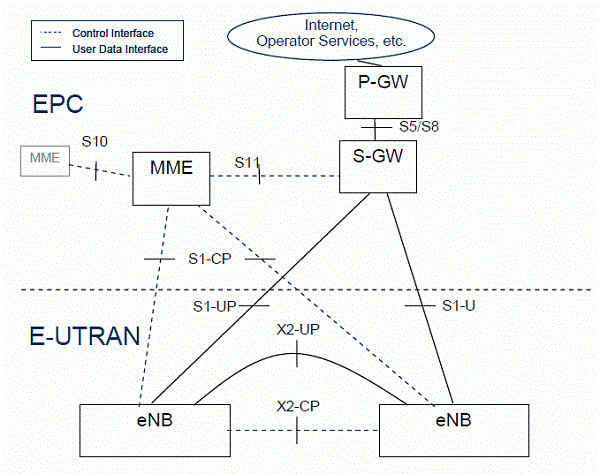The S1 interface in LTE is used between eNodeBs and the EPC: specifically, the MME and S-GW. In the user plane this interface will be based on GTP User Data Tunnelling (GTP-U) (similar to today’s Iu and Gn interface).
LTE Interfaces: Explaining the Interfaces in LTE
In the control plane, the interface is more similar to Radio Access Network Application Part (RANAP), with some simplifications and changes due to the different functional split and mobility within EPS.
The S1 interface includes the S1-CP (control) and S1-UP part (user plane). The signalling transport on S1-CP will be based on SCTP. The signalling protocol for S1 is called S1-AP.
S1 is a “many-to-many” interface.
S1 signaling bearer provides the following functions:
Support of any suitable data link layer protocol, e.g. PPP, Ethernet
SCTP is supported as the transport layer of S1-MME signalling bearer.
The S1 interface is the interface between the LTE RAN and evolved packet core. S1 interface protocol stack is described in Figure.
S1 performs the following functions:
The S1 user plane external interface (S1-U) is defined between the LTE eNodeB and the LTE S-GW. The S1-U interface provides non guaranteed data delivery of LTE user plane Protocol Data Units (PDUs) between the eNodeB and the S-GW. Transport network layer is built on IP transport and GTP-U. UDP/IP carries the user plane PDUs between the eNodeB and the S-GW. A GTP tunnel per radio bearer carries user traffic.
The S1-UP interface is responsible for delivering user data between the eNodeB and the S-GW. The IP Differentiated Service Code Point (DSCP) marking is supported for QoS per radio bearer.
The LTE S1-MME interface is responsible for delivering signaling protocols between the eNodeB and the MME. S1-MME interface consists of a Stream Control Transmission Protocol (SCTP) over IP and supports multiple UEs through a single SCTP association. It also provides guaranteed data delivery. The application signaling protocol is an S1-AP (Application Protocol). The LTE S1-MME is responsible for Evolved Packet System (EPS) bearer setup/release procedures, the handover signaling procedure, the paging procedure and the NAS transport procedure. LTE Transport network layer is built on IP transport, similar to the user plane but for the reliable transport of signaling messages SCTP is added on top of the Internet Protocol.
LTE/4G Interface Networking
LTE Interfaces: Explaining the Interfaces in LTE
In the control plane, the interface is more similar to Radio Access Network Application Part (RANAP), with some simplifications and changes due to the different functional split and mobility within EPS.
The S1 interface includes the S1-CP (control) and S1-UP part (user plane). The signalling transport on S1-CP will be based on SCTP. The signalling protocol for S1 is called S1-AP.
S1 is a “many-to-many” interface.
 |
| S1 LTE Interface |
The S1 signaling bearer
S1 signaling bearer provides the following functions:
- Provision of reliable transfer of S1-AP message over S1-MME interface.
- Provision of networking and routing function
- Provision of redundancy in the signalling network
- Support for flow control and congestion control
L2 – Data link layer
IP layer
- The eNB and MME support IPv6 and/or IPv4
- The IP layer of S1-MME only supports point-to-point transmission for delivering S1-AP message.
- The eNB and MME support the Diffserv Code Point marking
Transport layer
- SCTP refers to the Stream Control Transmission Protocol developed by the Sigtran working group of the IETF for the purpose of transporting various signalling protocols over IP network.
- There is only one SCTP association established between one MME and eNB pair.
- The eNB establishes the SCTP association. The SCTP Destination Port number value assigned by IANA to be used for S1AP is 36412.
S1 interface protocol
The S1 interface is the interface between the LTE RAN and evolved packet core. S1 interface protocol stack is described in Figure.
S1 performs the following functions:
- S1-UP (user plane)
- S1-CP (control plane)
 |
| S1 Interface in LTE 4G |
S1-UP (user plane)
The S1 user plane external interface (S1-U) is defined between the LTE eNodeB and the LTE S-GW. The S1-U interface provides non guaranteed data delivery of LTE user plane Protocol Data Units (PDUs) between the eNodeB and the S-GW. Transport network layer is built on IP transport and GTP-U. UDP/IP carries the user plane PDUs between the eNodeB and the S-GW. A GTP tunnel per radio bearer carries user traffic.
The S1-UP interface is responsible for delivering user data between the eNodeB and the S-GW. The IP Differentiated Service Code Point (DSCP) marking is supported for QoS per radio bearer.
LTE S1-MME (control plane)
The LTE S1-MME interface is responsible for delivering signaling protocols between the eNodeB and the MME. S1-MME interface consists of a Stream Control Transmission Protocol (SCTP) over IP and supports multiple UEs through a single SCTP association. It also provides guaranteed data delivery. The application signaling protocol is an S1-AP (Application Protocol). The LTE S1-MME is responsible for Evolved Packet System (EPS) bearer setup/release procedures, the handover signaling procedure, the paging procedure and the NAS transport procedure. LTE Transport network layer is built on IP transport, similar to the user plane but for the reliable transport of signaling messages SCTP is added on top of the Internet Protocol.
The S1 interface is crucial for connecting the LTE RAN to the Evolved Packet Core, ensuring smooth data transfer and control signaling. For anyone exploring network setups or troubleshooting, tools like the rookie sideloader can be handy for sideloading firmware or apps on devices related to LTE testing. This makes managing and optimizing LTE networks more accessible and efficient.
ReplyDeletePost a Comment